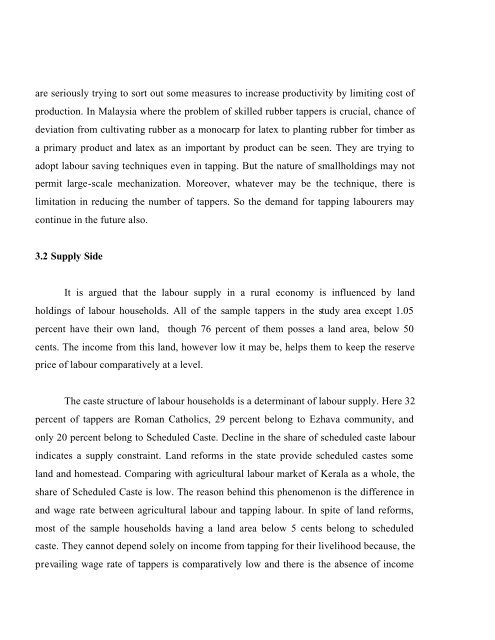socio-economic profile of rubber tappers in the small holding sector
socio-economic profile of rubber tappers in the small holding sector
socio-economic profile of rubber tappers in the small holding sector
Create successful ePaper yourself
Turn your PDF publications into a flip-book with our unique Google optimized e-Paper software.
are seriously try<strong>in</strong>g to sort out some measures to <strong>in</strong>crease productivity by limit<strong>in</strong>g cost <strong>of</strong><br />
production. In Malaysia where <strong>the</strong> problem <strong>of</strong> skilled <strong>rubber</strong> <strong>tappers</strong> is crucial, chance <strong>of</strong><br />
deviation from cultivat<strong>in</strong>g <strong>rubber</strong> as a monocarp for latex to plant<strong>in</strong>g <strong>rubber</strong> for timber as<br />
a primary product and latex as an important by product can be seen. They are try<strong>in</strong>g to<br />
adopt labour sav<strong>in</strong>g techniques even <strong>in</strong> tapp<strong>in</strong>g. But <strong>the</strong> nature <strong>of</strong> <strong>small</strong>hold<strong>in</strong>gs may not<br />
permit large-scale mechanization. Moreover, whatever may be <strong>the</strong> technique, <strong>the</strong>re is<br />
limitation <strong>in</strong> reduc<strong>in</strong>g <strong>the</strong> number <strong>of</strong> <strong>tappers</strong>. So <strong>the</strong> demand for tapp<strong>in</strong>g labourers may<br />
cont<strong>in</strong>ue <strong>in</strong> <strong>the</strong> future also.<br />
3.2 Supply Side<br />
It is argued that <strong>the</strong> labour supply <strong>in</strong> a rural economy is <strong>in</strong>fluenced by land<br />
hold<strong>in</strong>gs <strong>of</strong> labour households. All <strong>of</strong> <strong>the</strong> sample <strong>tappers</strong> <strong>in</strong> <strong>the</strong> study area except 1.05<br />
percent have <strong>the</strong>ir own land, though 76 percent <strong>of</strong> <strong>the</strong>m posses a land area, below 50<br />
cents. The <strong>in</strong>come from this land, however low it may be, helps <strong>the</strong>m to keep <strong>the</strong> reserve<br />
price <strong>of</strong> labour comparatively at a level.<br />
The caste structure <strong>of</strong> labour households is a determ<strong>in</strong>ant <strong>of</strong> labour supply. Here 32<br />
percent <strong>of</strong> <strong>tappers</strong> are Roman Catholics, 29 percent belong to Ezhava community, and<br />
only 20 percent belong to Scheduled Caste. Decl<strong>in</strong>e <strong>in</strong> <strong>the</strong> share <strong>of</strong> scheduled caste labour<br />
<strong>in</strong>dicates a supply constra<strong>in</strong>t. Land reforms <strong>in</strong> <strong>the</strong> state provide scheduled castes some<br />
land and homestead. Compar<strong>in</strong>g with agricultural labour market <strong>of</strong> Kerala as a whole, <strong>the</strong><br />
share <strong>of</strong> Scheduled Caste is low. The reason beh<strong>in</strong>d this phenomenon is <strong>the</strong> difference <strong>in</strong><br />
and wage rate between agricultural labour and tapp<strong>in</strong>g labour. In spite <strong>of</strong> land reforms,<br />
most <strong>of</strong> <strong>the</strong> sample households hav<strong>in</strong>g a land area below 5 cents belong to scheduled<br />
caste. They cannot depend solely on <strong>in</strong>come from tapp<strong>in</strong>g for <strong>the</strong>ir livelihood because, <strong>the</strong><br />
prevail<strong>in</strong>g wage rate <strong>of</strong> <strong>tappers</strong> is comparatively low and <strong>the</strong>re is <strong>the</strong> absence <strong>of</strong> <strong>in</strong>come










